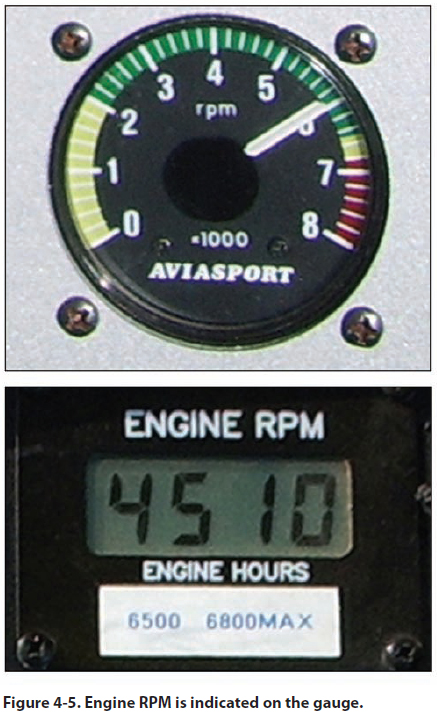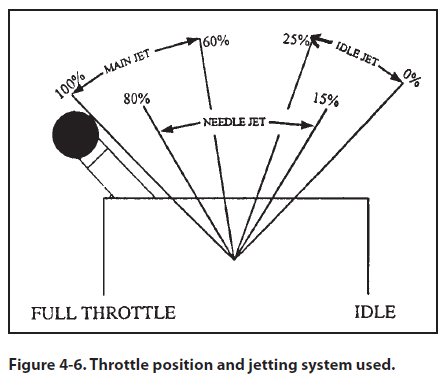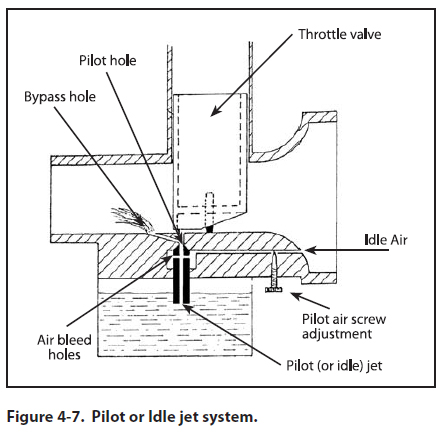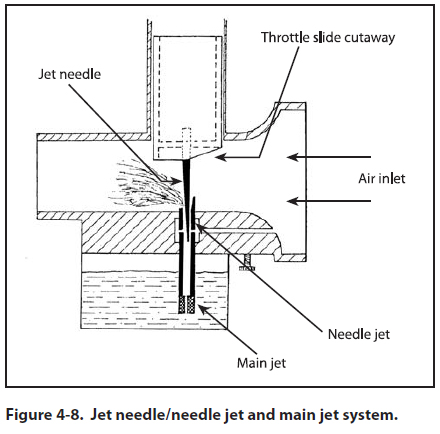|
Chapter 4 — Powerplants
Centrifugal Clutch
Some gearboxes come with a built-in centrifugal
clutch, and others have allowances for installation. A
centrifugal clutch is very useful in a two-stroke engine
because it allows the engine to idle at a lower speed
without the load of the propeller. Otherwise, twostrokes
can generate a lot of vibration at low RPM
when loaded. As the engine speeds up, the centrifugal
clutch engages the rest of the gearbox and smoothly
starts the propeller spinning. When the engine is
brought back to idle, the clutch disengages and allows
the engine to again idle smoothly; the propeller stops
when on the ground and windmills when flying.
Propeller
The propeller provides the necessary thrust to push
the powered parachute through the air. The engine
power is used to rotate the propeller, which in turn
generates thrust very similar to the manner in which
a wing produces lift. The amount of thrust produced
depends on the airfoil shape, the propeller blade angle
of attack, and the engine RPM. [Figure 4-5] Powered
parachutes are equipped with either a fixed-pitch or
ground adjustable pitch propeller.

Fixed-Pitch Propeller
The pitch of this propeller is set by the manufacturer
and cannot be changed. Refer to Chapter 5 of the
Pilot’s Handbook of Aeronautical Knowledge for basic
propeller principles.
Ground Adjustable-Pitch Propeller
Adjustable-pitch propellers for PPCs can only be adjusted
on the ground with hand tools. If an engine is
over-revving, more pitch can be added to the propeller.
If the engine is not developing the full recommended
RPM during flight, then some pitch can be taken out
of the blades. This should be done per the PPC’s POH
and by a qualified technician.
Induction Systems
The induction system brings air in from the atmosphere,
mixes it with fuel, and delivers the fuel-air mixture to the cylinder where combustion occurs.
Outside air enters the induction system through an air
filter on the engine. The air filter inhibits the entry of
dust and other foreign objects. Two types of induction
systems are used in powered parachute engines:
1. The carburetor system is most common; it mixes
the fuel and air in the carburetor before this
mixture enters the engine intake, and
2. The fuel injection system, which injects the fuel
into the air just before entry into each cylinder.
Carburetor Systems
PPCs use float-type carburetors. Reference the Pilot’s
Operating Handbook of Aeronautical Knowledge for
basics on float carburetor operation.
Modern two- and four-stroke carburetors operate with
one of three jetting systems, depending on engine
power. [Figure 4-6]

When the throttle is closed, for engine idling, the throttle
valve is closed and the fuel is supplied through the
idle (pilot) jet and idle (pilot) air passage. The fuel/air/oil mixture is supplied to the cylinders through the
bypass hole. [Figure 4-7]

As the throttle is advanced and the throttle valve is
raised, the fuel is sucked up through the main jet but
is controlled by the opening and taper of the jet needle
and needle jet. This is effective throughout most
of the mid range operation. About half throttle, the
main jet size starts to influence the amount of fuel
mixed with the air and this effect continues until it
is the main influence at the highest throttle settings.
[Figure 4-8]

|

